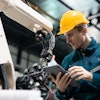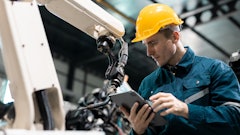
In a sector dominated by physical goods, supply chain leaders are embracing automation, AI, and the Internet of Things (IoT) to improve speed, accuracy, and cost-efficiency. In fact, 50% of warehouses over 1 million square feet already use autonomous mobile robots (AMRs). Just two years ago, the global warehouse automation market was projected to grow from $19.23 billion in 2023 to $69 billion by 2025, illustrating the rapid pace at which these technologies are being adopted.
Yet, despite this swift growth and technological proliferation, many supply chains continue to face inefficiencies, bottlenecks, and disruptions that can jeopardize performance and customer satisfaction. Why does the gap between investment and impact remain so stubborn?
The answer lies in how the technology is deployed – and more importantly, who is trusted to manage it. Automation and AI may be transformative tools, but they are not standalone solutions. Their success depends on the skilled human oversight needed to adapt, interpret, and optimize these systems for the unpredictable and dynamic realities of modern warehouse operations.
More robots equals more productivity
Too often, automation is implemented under the assumption that simply adding more machines guarantees more throughput. But that’s not always the case. These technologies excel in stable, repeatable environments and the real world rarely plays by those rules. Seasonal demand spikes, supplier delays, product variability, or sudden shifts in consumer behavior can quickly introduce chaos into otherwise well-orchestrated systems.
Automation – like goods-to-person systems designed to streamline fulfillment – can unintentionally create bottlenecks when managing multiple clients with competing, time-sensitive priorities. These systems need to flex, adapt, and respond in real time to exceptions, shifting demand, and order complexity across all operational types withing a building.
That flexibility doesn’t come from the robots – it comes from the people.
From frontline supervisors who manage both human and robotic workflows to data teams who find insights in operational metrics, the human element remains critical to warehouse success. That’s why the future of warehousing isn’t just about more automation – it’s about smarter humans who know how to turn insights into action.
The power of free data – If you know how to use it
Every warehouse generates “free data” as a byproduct of daily activity – equipment movements, order processing timestamps, labor scans, and more. Some of this data often goes unused, simply because teams don’t have the tools or training to turn it into insights. This is one of the biggest missed opportunities in modern warehouse operations.
Take cycle times, for instance. A data analyst might uncover that certain SKUs consistently move slower through the system. Armed with that insight, a supervisor can adjust workflows or resource allocation to address the delay. Similarly, predictive maintenance tools can signal potential equipment failure before it happens, but only if someone knows how to interpret the alerts and act.
Without people who can connect the dots, this data stays dormant, and the potential productivity gains remain untapped.
5 “personas” powering smarter warehousing
Building a smart warehouse isn’t just about plugging in automation – it’s about empowering five distinct personas who translate technology and data into action:
1. Site-level managers: Drive the big-picture decisions and lead overall operations. They synthesize cross-functional insights to align operational priorities, assess ROI, and adjust strategies based on real-time trends.
2. Frontline supervisors: Lead the daily execution. Now managing both people and machines, supervisors must dynamically allocate resources, manage real-time disruptions, and translate system outputs into immediate action.
3. Data scientists and analysts: Analyze large volumes of raw warehouse data to model workflows, spot inefficiencies, and deliver insights unfiltered by daily operational bias.
4. Planning and scheduling teams: Use AI to design labor plans that respond to volatility. Rather than building rigid schedules, they create flexible frameworks that handle exceptions and shift with demand.
5. Maintenance technicians: Leverage IoT and sensor data to perform proactive, predictive maintenance, ensuring equipment uptime and long-term ROI.
Together, these five key roles drive a repeatable, scalable approach to warehouse optimization—regardless of industry vertical, facility size, or client complexity.
Why the human element still matters
Advanced automation systems are highly effective at executing repetitive tasks. But they often falter in exception-based scenarios like weather delays or supplier issues – precisely where human experience and judgment are most critical.
When geopolitical instability disrupts supply lanes, or when demand surges suddenly outpace capacity, decision-making must be quick, context-aware, and creative. These are the moments where automation alone falls short—and where human teams step in to navigate complexity. Moreover, automation dashboards don’t always tell the full story. Issues like inefficient product sequencing or overlapping fulfillment queues may go undetected by the system but stand out to an experienced supervisor or analyst on the floor.
That’s why the ROI of automation isn’t fully realized at deployment. It’s achieved over time, through people who continually learn, adapt, and evolve both processes and technologies to meet changing conditions.
Building the workforce of the future
The promises and perils of advanced technologies mean they’re here to stay. The global demand for AI in logistics alone is projected to grow at a compound annual growth rate (CAGR) of 40.4%, reaching $58.55 billion by 2031. For supply chain leaders, the challenge isn’t whether to adopt these technologies, but how to ensure they work in tandem with human expertise.
To stay competitive, companies must invest as much in people as they do in tech. That means
· Upskilling frontline workers in systems thinking, exception handling, and data interpretation
· Equipping supervisors to manage hybrid teams of humans and machines
· Investing in data fluency and leveraging AI, so teams don’t just collect raw data but turn it into operational insights
· Building cross-functional collaboration between operations and analytics so that insights aren’t siloed – they’re shared and acted upon
Smarter supply chains aren’t just about buying smarter tools. They’re about having the right people who can make those tools work – who can turn raw data into smart decisions, and automation into agility. As AI, robotics, and digital systems continue to evolve, the most resilient and high-performing warehouses will be those where data doesn’t just exist – it’s harnessed by a workforce ready to put it to work.



















